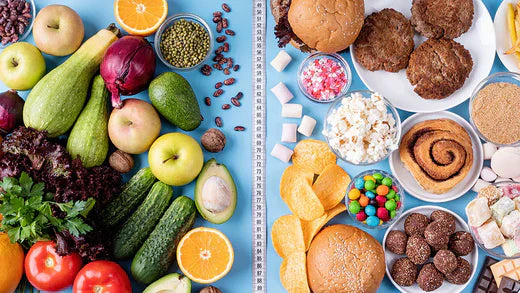
The Ultimate Keto Diet: How to Eat More Fat and Lose Weight
Share
With the prevalence of Type 2 diabetes, more people are suffering from excessive body fat and struggling to lose weight. There are two ways of losing body fat: one is by exercising, and the other is through certain types of diets. When it comes to diet, there are many options, such as Low-Carb Diet, Ketogenic Diet, Paleo Diet, DASH Diet, Mediterranean Diet, Plant-Based/Vegan Diet...
Today, let's delve into the science behind the diet that everyone seems to be obsessed with - the ketogenic diet.
The ketogenic diet, or keto, is a low-carb, high-fat medical diet that aims to put your body into ketosis, a metabolic state that burns fat for energy instead of carbohydrates. The ketogenic diet was first invented in 1921, by Russell Wilder, an American physician to treat epilepsy in children and adolescents. The diet has helped reduce the risk of seizures while providing the body with enough energy. Later on, more people with Type 2 diabetes started trying out the ketogenic diet, which gave them amazing results in losing body fat.
What are the health benefits of a ketogenic diet?
Apart from the obvious benefits of losing body fat, the ketogenic diet also has the following health benefits:
- Low-carb diet reduces appetite – Hunger can be the main hindrance to people who start a diet. However, people on a low-carb diet seem to have decreased appetite leading to less caloric intake.
- A Greater Proportion of Fat Loss Comes From Your Abdominal Cavity - A large percentage of the fat lost on low-carb diets tends to be harmful abdominal fat known to cause serious metabolic problems.
- Increased Levels of ‘Good’ HDL Cholesterol - Low-carb diets tend to be high in fat, which leads to an impressive increase in blood levels of “good” HDL cholesterol.
- Reduced Blood Sugar and Insulin Levels - Low-carb and ketogenic diets can also be extremely helpful for people with diabetes and insulin resistance.
- Managing Brain Disorder – As mentioned in the beginning, the ketogenic diet was first used to treat kids and adolescents with Epilepsy, still recommended by many doctors today. The ketogenic diet is now being studied for other brain conditions as well, including Alzheimer’s and Parkinson’s disease.
How to eat?
The ketogenic diet typically consists of 70–80% fat, 5–10% carbohydrates, and 10–20% protein from total daily calories. For a 2000 kcal diet, this translates to about 165 grams fat(75%), 50 grams carbohydrate(10%), and 75 grams protein(15%).
Use the energy density chart below to calculate your ratio:
|
Carbohydrate |
4 calories per gram (113 calories per ounce) |
|
Protein |
4 calories per gram (113 calories per ounce) |
|
Fat |
9 calories per gram (255 calories per ounce) |
|
Water, vitamins, and minerals |
Zero calorific value |

What to eat and what not to eat on a ketogenic diet? 
Here are some food that are best recommended on a ketogenic diet:
- Meats: Beef, pork, lamb, poultry, and other meats are great sources of protein and healthy fats.
- Fatty Fish: Salmon, mackerel, sardines, and other fatty fish are rich in omega-3 fats.
- Eggs: Whole eggs are nutritious and versatile. (Fried eggs are a better choice than boiled eggs)
- Cheese: Choose unprocessed cheeses like cheddar, goat cheese, cream cheese, or mozzarella.
- Butter and Cream: These are high in fat and low in carbs, making them suitable for a keto diet.
- Nuts and Seeds: Almonds, walnuts, flaxseeds, chia seeds, and pumpkin seeds are good choices.
- Avocados: These are very low in carbs and high in healthy fats.
- Low-Carb Vegetables: Leafy greens (spinach, kale), cauliflower, broccoli, zucchini, and peppers are good options.
- Berries: In moderation, berries like strawberries, blueberries, and raspberries can be included due to their lower sugar content compared to other fruits.
- Beverages: Water, coffee, and tea are great options. Avoid sugary drinks and fruit juices.
On a ketogenic diet, it's important to avoid or significantly limit foods that are high in carbohydrates, as they can interfere with reaching and maintaining ketosis. Here are foods to avoid or minimize:
- Grains: Wheat, rice, oats, barley, and other grains are high in carbohydrates and should be avoided.
- Sugary Foods: Candy, cookies, cakes, ice cream, and other sweets are high in sugar and carbs.
- Fruit: Most fruits, especially those high in sugar like bananas, apples, grapes, and oranges, should be limited due to their carbohydrate content.
- Starchy Vegetables: Potatoes, sweet potatoes, corn, peas, and other starchy vegetables are high in carbs.
- Legumes: Beans, lentils, chickpeas, and other legumes are relatively high in carbohydrates and should be avoided.
- Sugary Drinks: Soda, fruit juice, sweetened teas, and other sugary beverages should be avoided due to their high sugar content.
- Low-Fat or Diet Products: These often contain added sugars to compensate for reduced fat content.
- Processed Foods: Many processed foods contain hidden sugars and carbohydrates. Always check labels for carb content.
- Alcohol: Most alcoholic beverages are high in carbs. Some options like dry wines or spirits in moderation may be acceptable for some people, but they should be consumed sparingly and cautiously.
- Unhealthy Fats: While fats are encouraged on a ketogenic diet, avoid unhealthy fats such as trans fats often found in processed and fried foods.
How long does it take to go into ketosis?
Usually, it will take a couple of days to a week after you start on the keto diet. Although you have cut down the carbohydrates in your daily meals, there are still some carbs restored in your body for "emergencies". You have to wait for your body to use up all the stored carbs before fully entering ketosis.
How do I know if I'm in ketosis?
The easiest and most accurate way to confirm you're in ketosis is by testing your ketones with a blood ketone meter. However, a new option is now available—a Continuous Ketone Monitoring (CKM) device. This small biosensor provides real-time ketone readings for up to 14 days, allowing you to track how food, sleep, and exercise impact your ketone levels throughout the day. While breath and urine tests are also available for measuring ketones, they are significantly less accurate compared to blood and continuous monitoring methods.
What are the side effects/risks of keto?
- The low carb/keto flu – you might experience a short-term side effect that causes nausea, headache, fatigue, and decreased physical performance. While this may cause certain people to discontinue the diet, it’s usually over in a short amount of time.
- Elevated heart rate - This is also called heart palpitations or a racing heart. It can happen during the first few weeks of a ketogenic diet. Being dehydrated is a common cause, as well as low salt intake. Drinking a lot of coffee might also contribute to this. If the problem doesn’t stop, you might need to increase your carb intake
- Hypoglycemia. If you use medications to control your blood sugar levels, speak to a doctor before starting the diet, as they may need to adjust the dose.
Don’t expect to get into ketosis fast; it takes time for your body to adjust to your new metabolic state. Most importantly, consult your doctor before starting a ketogenic diet, as all diets may have certain side effects. Make sure to choose one that best suits your needs.


